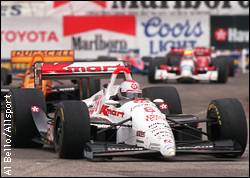

By Larry Schwartz
Special to ESPN.com
Vroom! That sound you hear is Mario Andretti speeding around the track. Whether it was Indy, Formula One, Formula 5000 or Sprint cars, he proved himself a winner at all levels of competition in his 36-year career.
Let's look at Andretti's record:
 | |
| Mario Andretti rounds the corner during the 1994 IndyCar
grand prix of Long Beach. |
Mario and his twin brother Aldo were born Feb. 28, 1940, in Montona, Italy, about the time World War II broke out. When the war ended, the borders were in dispute and the peninsula of Istria, where the town of Montona was located, fell under Communist rule. From 1948 to 1955, the family lived in a refugee camp. Finally granted a United States visa after waiting several years, the Andrettis began their new lives in the U.S. in June 1955. Settling in Nazareth, Pa., the family of five had $125 and didn't speak English.
The twins worked in an uncle's garage and in 1959 began racing a 1948 Hudson Hornet Sportsman Stock Car. They took turns behind the wheel, and in their first four races, each won twice. In the last race of the season, Aldo crashed, fracturing his skull. But he returned to competition a year later and raced another 10 years. He retired in 1969 after another major accident caused substantial facial injuries.
Meanwhile, Mario's career flourished from the start, as he won 20 races in the modified stock class in his first two seasons. His first Indy car appearance was on April 19, 1964 in Trenton, N.J., where he finished 11th after starting 16th. A year later, he won his first Indy car race (the Hoosier Grand Prix), earned Rookie of the Year honors at the Indianapolis 500 (he finished third) and won the first of his four Indy car championships.
 |
|
| Previous poll results |
After finishing second in the Indy car championships in 1967 and 1968, Andretti regained the title in 1969. He won nine races, including the Indy 500 when he averaged a then-record 156.867 mph in his STP Oil Treatment Special.
For several years, Andretti sought to juggle Indy car, Formula One, Formula 5000 and Can-Am racing. While he didn't have much success in Indy cars, he won the USAC dirt track championship in 1974 plus several Formula 5000 races, finishing second in the Formula 5000 series in 1973 and 1974. He also won the grueling 12 Hours of Sebring endurance race three times (1967, 1970 and 1972).
From 1975 to 1981, he focused primarily on the Grand Prix circuit, winning 12 races and earning 16 pole positions. The highlight of his international career was in 1978 when he won six Formula One races and became the second American (Phil Hill was the first in 1961) to win the world championship.
Probably the most bizarre race in Andretti's career came in the 1981 Indy 500. Bobby Unser beat him by eight seconds, but the following day Unser was penalized a lap for passing cars illegally under a yellow caution flag and Andretti was declared the winner. Unser and car-owner Roger Penske appealed the race stewards' decision to the U.S. Auto Club. Four months later, USAC overturned the ruling, saying the penalty was too harsh. It fined Unser $40,000 but gave him back the victory.
Andretti returned to Indy car racing full time in 1982 and two years later won his fourth championship, edging out runner-up Tom Sneva by 13 points. He captured the CART title by registering six victories and had nine poles in his 16 starts. Five of his six wins came from the pole.
In 1991, Andretti, at 51, finished seventh in the Indy car standings, while his son Michael won the championship. Mario Andretti also competed that season against his other son, Jeff, and a nephew, John, making it the first time four family members raced together in the same series.
The last of Andretti's record 407 Indy car races was in September 1994. His 52 Indy car victories are second to A.J. Foyt's 67 and his 67 pole positions remain No. 1 on the list. The winner of $11,552,154 in Indy car competition plus more than $1 million on other circuits, he is enshrined in three Halls of Fame -- the Indianapolis 500, the Sprint Car and the Motor Sports.
Retirement from racing hasn't slowed down Andretti. His name is now on a winery in Napa Valley, a car dealership, a chain of gas stations and a distributorship, a clothing line, a coffee-table book, car washes, go-kart tracks, car-care products, an IMAX movie, video games and replica cars. He does about 50 appearances a year worldwide for Texaco and accepts numerous requests to speak to corporate audiences.

